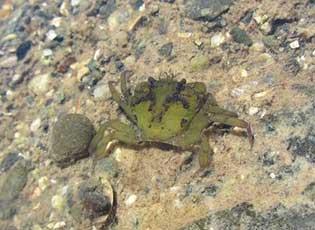Carcinus maenas (Linnaeus, 1758) (ITIS)
European green crab, shore crab, Joe rocker
Europe (Carlton and Cohen 2003)
1817 (East Coast); 1980s (West Coast) (Carlton and Cohen 2003)
Possibly through ballast water, hull fouling, or intentional releases (Carlton and Cohen 2003)
Severely impacts native bivalve and crustacean populations through predation and competition (See and Feist 2010)
North Atlantic coast; Pacific Coast

European green crab, adult
Photo by Caleb Siemmons; National Ecological Observatory Network
Find more images
Spotlights
Videos
All Resources
Selected Resources
The section below contains highly relevant resources for this species, organized by source.
Council or Task Force
Partnership
Federal Government
International Government
State and Local Government
Carlton, J.T. and A.N. Cohen. 2003. Episodic global dispersal in shallow water marine organisms: the case history of the European shore crabs Carcinus maenas and C. aestuarii. Journal of Biogeography 30(12):1809-1820.
Integrated Taxonomic Information System. Carcinus maenas. [Accessed Aug 31, 2023].
See, K.E., and B.E. Feist. 2010. Reconstructing the range expansion and subsequent invasion of introduced European green crab along the west coast of the United States. Biological Invasions 12:1305–1318.
